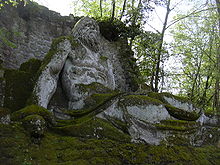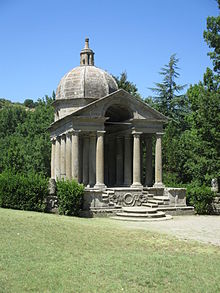Sacro Bosco
The Sacro Bosco (German Holy Forest ), also known as Park of the Monsters ( Italian Parco dei Mostri ), is a mannerist park equipped with grotesque monumental sculptures and antique architecture . It is located in a small wooded valley just north of the town of Bomarzo in the central Italian province of Viterbo on the northern edge of the Lazio region . There is no known comparable plant in Italy.
history
In more than 30 years of his life (1552–1585), Vicino Orsini , the last feudal lord of Bomarzo, had the sculpture park created by Pirro Ligorio , Giacomo Barozzi da Vignola and others. He dedicated it to his wife Giulia Farnese , who died in 1564 , daughter of Galeazzo Farnese (Duke of Latera ) - not to be confused with his grandmother (maternal) Giulia Farnese , the maitress of Alexander VI. By marrying an Orsini with a Farnese whose family with Paul III. Provided a pope in 1534, Bomarzo finally moved to the papal central state and was administered by cardinals.
Vicino Orsini died in 1585. After his death, the complex was forgotten. The weathered and completely overgrown sculptures were only rediscovered in the overgrown forest in the middle of the 20th century. Salvador Dalí was the first prominent visitor to the park in 1938; He evidently processed some of his motifs in his painting The Temptation of Saint Anthony (1946). In 1954 Giancarlo Bettini († July 30, 1997) and his wife Tina Severi Bettini († July 28, 1987) acquired the entire area and took care of extensive repairs in the second half of the 20th century. Historians and art historians became aware of the facility and a number of publications appeared. In the 21st century, the use of tourism under the new name "Park of Monsters" is an important economic factor for the municipality.
The sculpture forest
Through an orchard, the visitor reaches the sacred forest over the Fosso della Concia stream , which meanders through the Sacro Bosco valley . Approx. 300 m west of two sphinxes, a monumental glaucoma bares its teeth.
The 30 remaining sculptures and architectural compositions made from the locally abundant peperin rock of volcanic origin are located on an area of around 2 km² northeast of the stream. After some monumental sculptures (fighting giants, female figure on turtle, Pegasus ), nymphs and fountains, a small Greek-style theater is accessible via mossy steps. To the north of a crooked house ( Casa Pendente ) extends a terrace surrounded by Greek vases, around which other monumental sculptures are grouped: Neptune - Pluto according to another interpretation - a dolphin, a sleeping woman, a dragon, Ceres and an elephant.
Further north, the visitor can descend into the open mouth of the Orcus into a dark chamber. Outside again, he crosses an open space with a monumental Greek vase in the middle; Passing a so-called “Etruscan bench” (origin and actual function unclear), the circular route leads to another terrace to the west, bordered by stone pine cones and acorns. Again this terrace is surrounded by sculptures, namely Cerberus with three heads, two furies , two bears with the family coat of arms of the Orsini, lions and sirens .
A rotunda is located on a hill , from which a wide view of the town hill of Bomarzo opens up. The restorers Bettini are buried in an octagon temple . Whether it is also a mausoleum for Giulia Farnese is suspected from traditional hints of the count, but has not yet been proven.
Interpretations
In an inscription above the Etruscan bench, Vicino Orsini seems to explain to the visitor his intention to create a park of miracles for those who wander through the world ( Voi che pel mondo gite errando vaghi di veder meraviglie alte et stupende - you, who you through the world wanders on vague journeys to see the lofty and astonishing wonders ... ). On the terrace lined with pine cones and acorns, another inscription reveals that it is a Sacro Bosco (Sacred Forest).
The entire forest of sculptures is full of inscriptions that are more confusing than illuminating. Numerous individual interpretations have already been attempted, but an overarching concept or moralizing program that has been searched for repeatedly could not be proven in the end.
In any case, figures from Greek mythology are combined with ancient historical and literary motifs from the Renaissance. The elephant has been associated with Hannibal .
A slightly modified quote from Petrarch's Canzoniere (Sonnet No. 293) was read in the inscription on a stump of a pillar: Sol per sfogare il core - “Only to vent your heart”. Other interpreters claim to have found a similar quote from Vittoria Colonna .
In the monumental figures - from the battle of the giants to the Orcus - motifs from Ariost's Furious Roland have been recognized; an inscription refers to "Anglante", as the protagonist is alternatively called in Ariostus. The forest as a place of action in which strange things happen plays a key role in the Rasender Roland. There is also a magic forest with rivers and spring water ( Selva di Oronte ) in Bernardo Tasso's processing of the Amadis de Gaula fabric ( L'Amadigi di Francia ); This is in turn indicated by an inscription on a Greek vase that the guardians of this source are day and night in order to avert any injustice from it.
All of these assignments appear plausible in connection with Vicino Orsini, whose historical and literary background has been verified to this extent.
Other tricks in the park, however, refuse to be logically assigned. The fact that there is a table in Orcus' throat that invites you to a banquet is just as strange as the saying under the monster's nose: Ogni pensiero vola - "Every thought flies".
In view of the many unsolved puzzles in the classifications, the thesis that an overall concept does not exist is still valid; rather, Orsini deliberately wanted to cause chaos and confusion in the viewer. The thesis is not inconclusive, because Orsini leaves exactly this point open in another inscription: Tu ch'entri qua con mente parte a parte et dimmi poi se tante meraviglie sien fatte per inganno o pur per arte - “You, who you piece for If you come in here with understanding, tell me afterwards whether so many miracles were made out of the intent to deceive or for the sake of art ”. Since the Italian word can mean not only “art” but also “magic” (in the aesthetic as well as in the magical sense), this request is subtle and ambiguous.
Tourist use
Few of today's visitors go to the “Park of the Monsters” - it was only given this name at the end of the 20th century - with a scientific interest. Families with children from Viterbo to Rome are looking for a peculiar mixture of horror, amazement, puzzles, games and fun on a Sunday excursion to the “Holy Forest”.
There are souvenir stands and a self-service fast food restaurant in the entrance area ; agricultural products from the region can be purchased. Picnic areas, mini zoo and playground also make the park family-friendly. The park is particularly popular on the weekends in the summer months. A foreign audience also comes by on the way to Rome or as part of a day trip. Bomarzo's infrastructure is not geared towards permanent guests and package tourism, but the jobs that have been created through the care and maintenance of the park are an important economic factor for the small community.
literature
sorted alphabetically by author
- Horst Bredekamp and Wolfram Janzer (photos): Vicino Orsini and the Sacred Forest of Bomarzo. A prince as artist and anarchist (= Green Series. Volume 7). 2nd, revised edition. Wernersche Verlagsgesellschaft, Worms 1991, ISBN 3-88462-061-4 .
- Maurizio Calvesi : Gli incantesimi di Bomarzo. Il Sacro Bosco tra arte e letteratura. Bompiani, Milano 2000, ISBN 88-452-4519-5 .
- Mario Rodríguez Cobos (Silo): El bosque de Bomarzo. Obras Completas II. Plaza y Valdes, México DF 2002, ISBN 970-722-056-2 .
- Margaretta J. Darnall, Mark S. Weil: Il Sacro Bosco di Bomarzo. Its 16th-century literary and antiquarian context. In: Journal of garden history. Volume 4, 1984, ISSN 0144-5170 , pp. 1-94 (English).
- Salvatore Fosci: Vulcano nascosto. Una interpretazione alternativa del Bosco Sacro di Bomarzo (= I polifemi. Volume 2). Edited by Sigfrido E. F. Höbel. Stamperia del Valentino, Naples 2018, ISBN 978-8-899937-12-6 .
- Gunda Hinrichs: The sacred forest of Bomarzo. An enigmatic Italian Renaissance garden and Freud's dream interpretation as a method of its interpretation. Gebr. Mann, Berlin 1996, ISBN 3-7861-1283-5 .
- Luke Morgan: The Monster in the Garden. The Grotesque and the Gigantic in Renaissance Landscape Design (= Penn Studies in Landscape Architecture ). University of Pennsylvania Press, Philadelphia, Pa. 2015, ISBN 978-0-8122-4755-8 .
- Elli Mosayebi, Christian Mueller Inderbitzin: Bomarzo - observations using a new map (= pamphlet. 3). Institute for Landscape Architecture, ETH Zurich, 2005, ISBN 3-906441-06-7 .
- Bruno J. Richtsfeld: The "holy forest" of Bomarzo and its "hell mouth". In: Metamorphoses. A comparison of works by Werner Engelmann and ethnographic objects. Edited by Werner Engelmann and Bruno J. Richtsfeld. Staatliches Museum für Völkerkunde, Munich 1989, ISBN 3-927270-01-6 , pp. 18–36 (exhibition catalog).
- Stephen Wass: Parco di Monstri, Bormazo: Some Preliminary Observations on the Use of Water. In: Garden History . 45 (1/2017), ISSN 0307-1243 , pp. 3–20.
- Renate Vergeiner: Bomarzo. A garden against God and the world. Birkhäuser Verlag, Basel 2017, ISBN 978-3-0356-1203-5 .
Web links
- Official site Sacro Bosco (English and Italian)
- Il Parco dei Mostri di Bomarzo at bomarzo.net (English and Italian)
- Sacro Bosco virtual tour (French)
- Interpretation attempts with further references (Italian)
- Il Parco dei Mostri di Bomarzo. Visita Virtuale (Italian)
- Individual architectures in the Park of Monsters: mouth of hell , Tempietto von Vignola , inclined house ( memento from March 4, 2016 in the Internet Archive ), gigantic battle
Individual evidence
- ↑ Nikolaus Halmer: Art of living in the "Park of the Monsters". In: science.orf.at. ORF , May 29, 2017, accessed May 30, 2017.
Coordinates: 42 ° 29 ′ 26.3 " N , 12 ° 14 ′ 42.9" E







